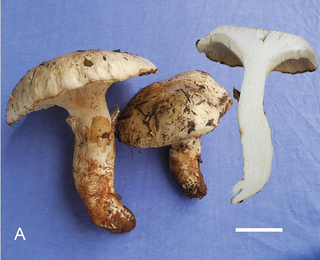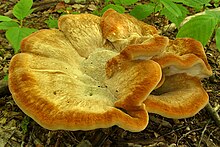
The Russulales are an order of the Agaricomycetes,. According to the Dictionary of the Fungi, the order consists of 12 families, 80 genera, and 1767 species. According to Species Fungorum, the order contains 13 families, 117 genera, and 3,060 species.

The Agaricales are an order of fungi in the division Basidiomycota. As originally conceived, the order contained all the agarics, but subsequent research has shown that not all agarics are closely related and some belong in other orders, such as the Russulales and Boletales. Conversely, DNA research has also shown that many non-agarics, including some of the clavarioid fungi and gasteroid fungi belong within the Agaricales. The order has 46 extant families, more than 400 genera, and over 25,000 described species, along with six extinct genera known only from the fossil record. Species in the Agaricales range from the familiar Agaricus bisporus and the deadly Amanita virosa to the coral-like Clavaria zollingeri and bracket-like Fistulina hepatica.

The Bondarzewiaceae are a family of fungi in the order Russulales. The type species for both its genus and the family as a whole, Bondarzewia montana, closely resembles members of Polyporales, but has ornamented spores like those of Lactarius or Russula. This characteristic suggested the relationship between physically dissimilar species that eventually led to the restructuring of Russulales using molecular phylogeny. According to the Dictionary of the Fungi, the family contains 8 genera and 48 species.

Pluteus is a large genus of fungi with over 300 species. They are wood rotting saprobes with pink spore prints and gills that are free from the stem.
Gastón Guzmán Huerta, a Mexican mycologist and anthropologist, was an authority on the genus Psilocybe.

Lucien Quélet was a French naturalist and mycologist. Quélet discovered several species of fungi and was the founder of the Société mycologique de France, a society devoted to mycological studies.

Members of the Monoblepharidomycetes have a filamentous thallus that is either extensive or simple and unbranched. They frequently have a holdfast at the base. In contrast to other taxa in their phylum, some reproduce using autospores, although many do so through zoospores. Oogamous sexual reproduction may also occur.

Catathelasma is a genus of fungi in the family Biannulariaceae. Basidiocarps are agaricoid, with a conspicuous veil, adnate to decurrent lamellae, and amyloid basidiospores. The genus is separated on DNA characteristics as well as morphology. Species are known from North America, Europe, and Asia and are ectomycorrhizal, forming an association with the living roots of trees.
Diacanthodes is a genus of three species of poroid fungi in the family Meruliaceae.
Marinus Anton Donk was a Dutch mycologist. He specialized in the taxonomy and nomenclature of mushrooms. Rolf Singer wrote in his obituary that he was "one of the most outstanding figures of contemporary mycology."

Catathelasma imperiale, also known as Catathelasma imperialis, and commonly known as the imperial mushroom, Hutsul mushroom, or korban, is a species of agaric in the family Biannulariaceae. Basidiocarps are stocky, with a double annulus (ring), and a tapering to rooting stipe (stem). The species is ectomycorrhizal with conifers and is found in continental Europe and Asia. Reports from North America are unconfirmed and may refer to Catathelasma evanescens or similar species. Fruit bodies are edible and collected for food in China and elsewhere. The species is widespread but uncommon and is assessed as globally "near threatened" on the IUCN Red List of Threatened Species.

Xanthoconium stramineum is a species of bolete fungus and the type species of the genus Xanthoconium. First described as a species of Gyroporus by William Alphonso Murrill in 1940, it was placed in its current genus by Rolf Singer in 1944.

Bondarzewia berkeleyi, commonly known as Berkeley's polypore, or stump blossoms, is a species of polypore fungus in the family Russulaceae. It is a parasitic species that causes butt rot in oaks and other hardwood trees. A widespread fungus, it is found in Africa, Asia, Europe, and North America.
Bondarzewia guaitecasensis is a species of polypore fungus in the family Russulaceae that is found in South America. Originally described as Polyporus guaitecasensis by German mycologist Paul Christoph Hennings in 1900, it was transferred to the genus Bondarzewia by Jorge Eduardo Wright in 1964. The fungus is parasitic on species of Nothofagus.

Bondarzewia mesenterica is a species of polypore fungus in the family Bondarzewiaceae. It was first described as Boletus mesentericus by Jacob Christian Schäffer in 1774. Hanns Kreisel transferred it to the genus Bondarzewia in 1984. The species is edible.










